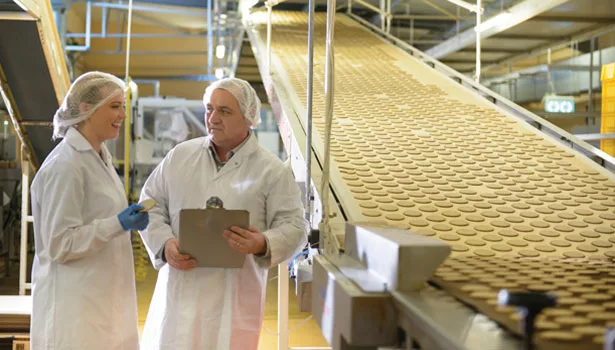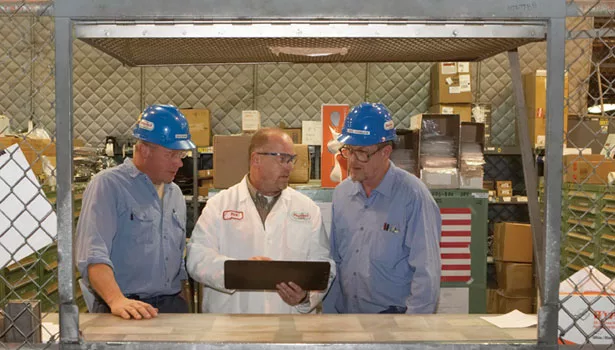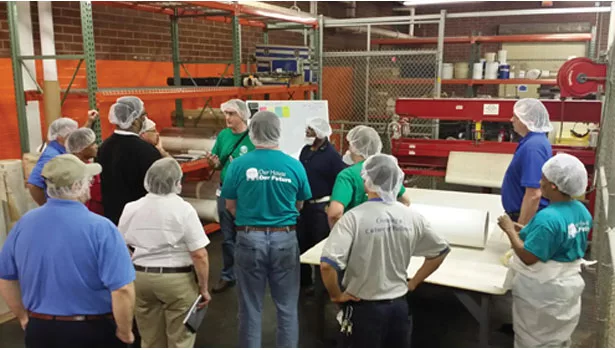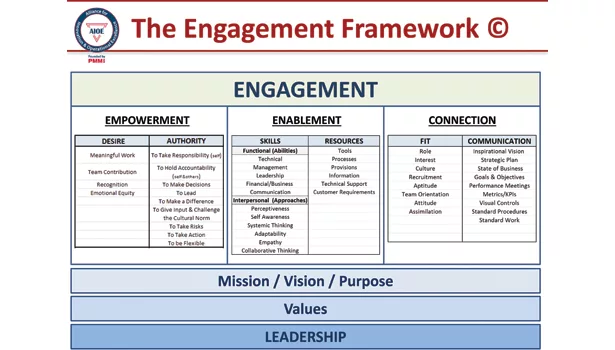The Plant Floor Worker
Employee engagement: Creating a culture of operational excellence
Employee engagement supports plant safety, food safety and operational efficiency goals. Could your operation be doing more to create a culture of engagement?








“Engaging for Success: Enhancing Performance Through Employee Engagement,” a study for the UK government, found companies with low employee engagement earn an operating income 32.7 percent lower than counterparts with more engaged employees. And according to a Corporate Leadership Council study of 50,000 workers, it’s all about company culture—or as the study puts it, “commonly used segmentation techniques based on tenure, gender or function do not predict engagement. Instead, dramatic differences between companies suggest that engagement levels are determined more by company strategies and policies than any characteristics regarding the employees themselves.”
Gallup’s “2012 State of the American Worker” report laid bare the impacts of improved engagement on key performance indicators, including an over 40 percent reduction in safety-related incidents and quality defects and a 37 percent reduction in absenteeism. Productivity and profitability, meanwhile, each saw increases exceeding 20 percent.
The Alliance for Innovation and Operational Excellence (AIOE), an initiative of PMMI, recently launched a workforce development group with the goal of “creating a comprehensive resource library that will start plant managers on a journey to achieve a more highly engaged workforce that generates improved individual, team and overall operational performance.”
The group, along with industry partners such as Campbell Soup, Hormel, General Mills, Leprino, Snyder’s-Lance and Sunny Delight, has produced a framework for engagement including six key attributes and the requisite characteristics for each at a company’s beginning, intermediate and advanced stages of engagement (see figure on page 36).
In AIOE’s framework, empowerment, enablement and connection are the three building blocks of engagement. Each of these elements is further comprised of attributes which can be tracked along an employee engagement journey from traditional to beginner, intermediate and advanced levels.
For instance, one attribute of empowerment is the authority to make decisions. AIOE’s Engagement Model Attributes Guide tracks decision-making as an element of employee engagement. It begins with a traditional organization, where workers are told what to do by managers. The next step is beginner level, where teams begin to voice options and opinions to improve the organization, and leaders begin to listen. At the intermediate level, teams recognize asking why and offering ideas are often not enough, and why decisions frequently must be made in real time. Finally, at the advanced level, teams understand the operational environment and its interdependencies, and work to make real-time decisions based on business goals and organizational values.
Ultimately, AIOE will offer examples of what has and hasn’t worked for food and beverage manufacturers, leadership guidance and a list of proven resources in the language and context of consumer product goods companies.
“There’s a whole lot written on the topic of workforce engagement, but the reality is, as it relates to getting it down from the theoretical into application, there’s very little,” says Steve Schlegel, managing director of AIOE. “Fundamentally, what’s really strong about workforce engagement is the value proposition that you’re going to recruit better, you’re going to retain more, and those who are engaged will produce more.”
Hiring and training
Given the importance of plant floor workers to plant safety, food safety and production success, identifying quality candidates and providing comprehensive training immediately after they’re hired are of paramount importance.
According to “Developing & Engaging the Manufacturing Workplace,” a 2012 white paper compiled by Booz & Company for PMMI, AIOE and the Grocery Manufacturers Association, 73 percent of executives surveyed listed problem-solving as among the most difficult skills to locate in potential production labor hires; 55 percent said the same about potential technical labor hires. One respondent said the shortage of problem-solving skills capabilities, combined with hesitation among younger workers to seek jobs in manufacturing and the elimination of plant-based human resources personnel, are the primary reasons for an increase of two weeks in 2007 to three weeks in 2012 in the average time required to locate and hire a consumer goods production worker. Over the same period, the average time required to hire a technical worker increased from six weeks to 10.
Because a food and beverage plant typically hires far fewer new workers in a given year than, for example, a car manufacturer, it can be difficult to convince community colleges to devote a significant portion of their curriculum to consumer goods manufacturing. As a result, very few students graduate with the skills necessary to work in a food and beverage facility, leaving employers to pick up the slack on training.
Hormel Foods has been an enthusiastic adopter of onsite training, with a curriculum focusing on continuous improvement and problem solving. Featuring a full-scale training center built to mimic the plant floor, the company’s Dubuque, IA facility is linked to a computer and video lab for testing and simulation-based learning.
Robert D. Christiansen, Hormel’s corporate manager of safety and security, says the company’s corporate safety department’s monthly “Our Way to Safety” employee training program is another important tool for staff training.
“Plant safety managers coordinate monthly train-the-trainer safety meetings for plant supervisors,” he says. “Examples of topics covered by the training include electrical safety, emergency action plans, ergonomics, the global harmonized system for hazard communication, inclement weather, lockout, control of hazardous energy, machine guarding and personal protective equipment.”
At Campbell Soup, training focuses on developing plant floor capability, strengthening technical knowledge and abilities, improving team performance and enhancing leadership skills, according to Eric Fidoten, vice president of global supply chains strategy and operations.
“We use a variety of training approaches to develop plant floor capability, strengthen technical knowledge and abilities, improve team performance and enhance leadership skills,” Fidoten says. “We’ve been particularly focused on our ability to coordinate on-demand technical and leadership training to deliver vertical startups of major capital investments.”
Problem-solving skills and continuous improvement tools are important components of the skill set required in today’s factories, and training new workers requires an active approach.
“Some organizations are backing up their workforce development goals with comprehensive training—either on their own or by collaborating with other organizations, especially in the areas of continuous improvement tools and problem-solving methodologies. The bottom line is, in today’s environment, developing skill sets is a strategic imperative that must be pursued with intent.
“Food production is a rather sacred responsibility for every team member involved in providing high-quality, safe products to the brands and labels we support,” says Jeremy Kacuba, vice president of operations, CPG at SunOpta. “As such, many of our roles have several testing criteria that require training and involvement both from internal resources and from the state agricultural departments.”
Communications, ergonomics and engagement
Ergonomics programs and communications protocols are essential components in driving employee engagement, which in turn translates into food safety, plant safety and improved efficiency. While the perceived cost of ergonomics programs are frequently cited as a barrier to implementation, a study of 250 ergonomics case studies by the Washington State Department of Labor & Industries and the Puget Sound Human Factors and Ergonomics Society (PSHFES) found tangible benefits to these programs including employee engagement. Companies wondering if an ergonomics program could benefit their operation may download a free cost-benefits calculator designed by PSHFES Labor and Industry Ergonomist Rick Goggins at www.pshfes.org/cost-calculator.
The study found best practices in ergonomics included involving groups like engineering, purchasing and facilities; evaluating and improving lighting, glare, temperature, noise levels and other environmental factors; evaluating the program and making continuous improvements; and involving employees in planning changes.
Fidoten says Campbell Soup factors ergonomic design into all new capital investments, not only playing into the company’s ability to maintain a safe work environment but also maximizing employee performance and increasing productivity and engagement.
“We also maintain dedicated plant teams that identify and work to eliminate legacy issues throughout our network,” says Fidoten. “These investments, coupled with other supply chain initiatives, have helped us achieve best-in-class safety performance in relation to peer food companies.”
SunOpta uses ergonomic reviews to justify capital improvements for work involving repetitive motions. “Our principal machinery goes through a full safety review as part of the design phase at the OEM which incorporates the basic principles of ergonomic design,” says Kacuba. “We expect all of our folks to look out for one another’s well-being and to generate ideas via our many safety teams. This involvement and voice are most crucial to working on the right priorities with regards to human safety.”
According to Charles J. Knopick, senior staff industrial engineer at Hormel Foods, ergonomic design, leveraging a combination of experience and ergonomic checklists, is a consideration in Hormel’s initial plant design and all subsequent changes.
“Through this process, we incorporate methods and equipment for plant floor workers to limit the frequency and the amount of weight they handle,” says Knopick. “We include adjustable floor stands with all our production lines to provide enough adjustability for them to be set to the correct working height for each employee.”
Communication between workers on the floor and between workers and management is another area plant operations leadership can leverage to drive employee engagement. Strong communication practices enable more effective training, as well as consistent reinforcement.
“Communications is always an opportunity, [and] we have made a very concerted effort to be world class in by creating dialogue with all of our employees,” says Kacuba. “From our CEO’s Quarterly Town Hall videos to executives conducting plant communication meetings, monthly ‘all-hands’ reviews and a focus on daily management and communication practices, we endeavor to keep all team members well informed of business-critical information and how we are winning in the market.”
At Snyder’s-Lance, communication is considered essential to success: “When we don’t communicate clearly with people, they will fill in the void with what makes sense to them, which is typically based upon past experience and beliefs,” says Jeremy R. Bowen, director of operations.
“As leaders, it’s critical that we consistently communicate and message what is important in our organization and do so in many different forums,” Bowen continues. “We communicate through communication meetings, pre-shift meetings, postings in the plant and obviously the dreaded email. As we move forward, we are looking to leverage technology to better communicate information.”
Successful outcomes
A culture of employee engagement translates to positive outcomes for overall production and operational efficiency, and the first step is measuring employee engagement through the use of some basic indicators.
“In a similar fashion to most organizations, we use the basic diagnostics of total recordable instance rate [TRIR], turnover and absenteeism to help understand the basic climate of behaviors,” says Kacuba. “We also couple this with employee engagement surveys.”
At Campbell Soup, Fidoten says leaders are accountable for creating the right culture. “We leverage organizational design, systems and processes to continually increase employee engagement. This creates a high-performance organization with a culture that reinforces accountability, teamwork and integrity.
“Overall performance is managed and maintained through our daily direction setting [DDS] approach, as well as through established KPIs. DDS is our core process to diagnosis and solve problems or, if need be, quickly and effectively elevate complex challenges to more sophisticated problem-solving forums,” he continues. “For complex problems, we systematically resolve them using our global operational excellence tools such as Lean, Six Sigma and TPM to engage the appropriate cross-section of our operation.”
It’s important to remember the central value proposition of employee engagement—that engagement will increase the magnitude of work that can be completed by any organization. “The more engaged a team is, the more they are going to give their discretionary effort and take care of things that won’t require the leader to identify, delegate or manage,” says Bowen. “Leaders need to think of this as an investment strategy and focus on building relationships and being very transparent with what is going on with the business and what is required by the team for the business to succeed.”
As Kacuba says, the hardest part of implementing a culture of engagement is simply finding time to do it. “We all have a pile of email and voicemail to deal with each day, and no shortage of meetings to attend. If we all did a brief diagnosis on those emails, voicemails and meetings, I bet we would find that many of them relate to problems on the plant floor,” he says. “We can choose to maintain a focus on driving from the rear-view mirror or make the more productive choice, and go out and engage our folks and prevent the problems before they have an opportunity to surface.”
Pre-construction and the plant floor workerFrom ergonomics to communications, proper pre-construction planning can incorporate features that simultaneously support worker engagement, productivity, plant floor safety and food safety. “Pre-construction for both food and plant safety begins with understanding the procedures of the food facility, how its operational processes work and how its workflow process has been engineered,” says Stuart Jernigan, director of pre-construction for A M King. “A strong pre-construction effort will build upon these requirements by setting priorities at the earliest stages. Plant worker relationships and the key elements of every position must be identified, and these will guide the safety measures necessary to be designed and budgeted into a project.” Plant and food safety planning is one pre-construction component of improving production efficiency, but driving employee engagement through ergonomic and communications-friendly practices can have a significant impact as well. “Studies have shown productivity increases when employees work in a facility with more ergonomic features,” says Jernigan. “This includes features such as the introduction of natural light into work spaces or break areas, the elimination of continual bending and lifting, and the elimination of safety hazards.” Careful planning, budgeting and design are key here, he continues. “It has been our experience that by introducing ergonomics into the design and planning stage, we develop a process layout which can make the employee’s work easier, safer and more productive—often at no additional building cost.” Pre-construction planning may also mitigate some common issues plaguing plant floor communications. Loud equipment, long distances between work stations and poorly designed process workflows can impair important inter-worker communication and result in downtime, lost efficiency and other undesirable outcomes. One option is to include plant floor personnel in the design and engineering process to provide insights on the amount of communication required between different work stations and personnel. |
For more information:
Steve Schlegel, AIOE, 571-332-4594, sschlegel@pmmialliance.org,
www.pmmi.org/aioe
Stuart Jernigan, A M King, 704-365-3160, sjernigan@amkinggroup.com,
www.amkinggroup.com
Looking for a reprint of this article?
From high-res PDFs to custom plaques, order your copy today!











